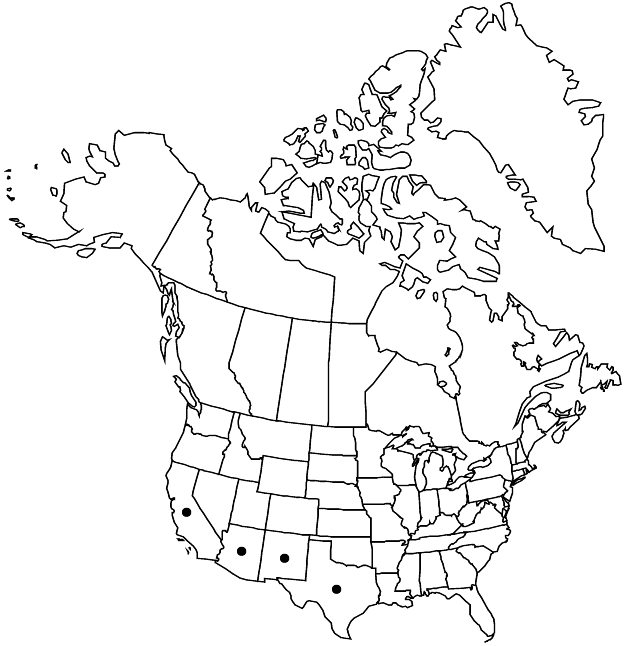Silene laciniata
Icon. 6: 44, plate 564. 1801.
Plants perennial; taproot thick, fleshy; caudex branched. Stems 1–several, straggling to erect, sometimes decumbent at base, simple or much-branched distally, 20–120 cm, puberulent or scabrous-pubescent, sometimes retrorse, often glandular distally, becoming glabrate proximally. Leaves sessile or narrowed at base into pseudopetiole, blade pubescent on both surfaces; proximal with blade lanceolate and oblanceolate, broadest distally or distal often reduced, cauline longest near mid stem, blade linear to lanceolate or elliptic, 1.5–10 cm × 2–30 mm. Inflorescences from 1-flowered to simple dichotomy to compound and 3–5–many-flowered with elongate branches; bracts small, linear-lanceolate, or resembling leaves. Pedicels elongate, much exceeding calyx. Flowers: calyx green, 10-veined, broadly tubular, 12–25 × 4–8 mm in flower, narrower towards base, middle broadening to 6–13 mm in fruit, narrower at both ends, pubescent, glandular, lobes lanceolate, 2.5–5 mm, margins membranous or not, apex ± obtuse; corolla scarlet, clawed, claw equaling or longer than calyx, limb lobed, often deeply so, lobes 4–6, linear, lanceolate, or oblong, small lateral teeth may be present, 6–15 mm, appendages inconspicuous, 1–2 mm, dentate; stamens longer than corolla claw but shorter than lobes; stigmas 3, equaling corolla. Capsules oblong to ovoid or broadly tubular, equaling calyx, opening by 6 ascending teeth; carpophore 2–4 mm. Seeds reddish brown, broadly reniform, 1.7–2.3 mm, sides tuberculate, margins papillate.
Distribution

Ariz., Calif., N.Mex., Tex., Mexico.
Discussion
Subspecies 3 (3 in the flora).
The large, beautiful scarlet flowers of Silene laciniata are bird- and butterfly-pollinated. The species occurs in three forms. Subspecies laciniata has narrow leaves, much-branched and many-flowered, open inflorescences, and oblong capsules. Subspecies californica has ovate to lanceolate leaves, few-flowered inflorescences, and ovoid capsules. These two entities both occur in California and Mexico. Although they are usually distinguishable, apparent intermediates occur. The third entity is subsp. greggii, which occurs in Arizona, southwestern Texas, and Mexico. It combines characters of the other two subspecies, having broader leaves, a branched and many-flowered open inflorescence, and a capsule of intermediate shape.
Selected References
None.
Lower Taxa
Key
| 1 | Inflorescences poorly developed, usually 1-3(-5)-flowered; stems straggling, sparsely branched, leafy throughout; distal leaf blades and bracts lanceolate to ovate-lanceolate; capsules ovoid; fruiting calyces obovate to turbinate, more than 1/ 2 as broad as long | Silene laciniata subsp. californica |
| 1 | Inflorescences well-developed, (3-)5+-flowered; stems erect or ascending, sometimes with decumbent base, branched distally; distal leaves reduced, blade linear or lanceolate to elliptic; capsules oblong or broadly tubular; fruiting calyces less than 1/ 2 as broad as long | > 2 |
| 2 | Distal leaf blades linear to lanceolate, proximal leaf blades lanceolate to oblanceolate; California, Mexico | Silene laciniata subsp. laciniata |
| 2 | Distal leaf blades lanceolate to elliptic, proximal leaf blades oblanceolate, often broadly so; Arizona to sw Texas, s into Mexico | Silene laciniata subsp. greggii |